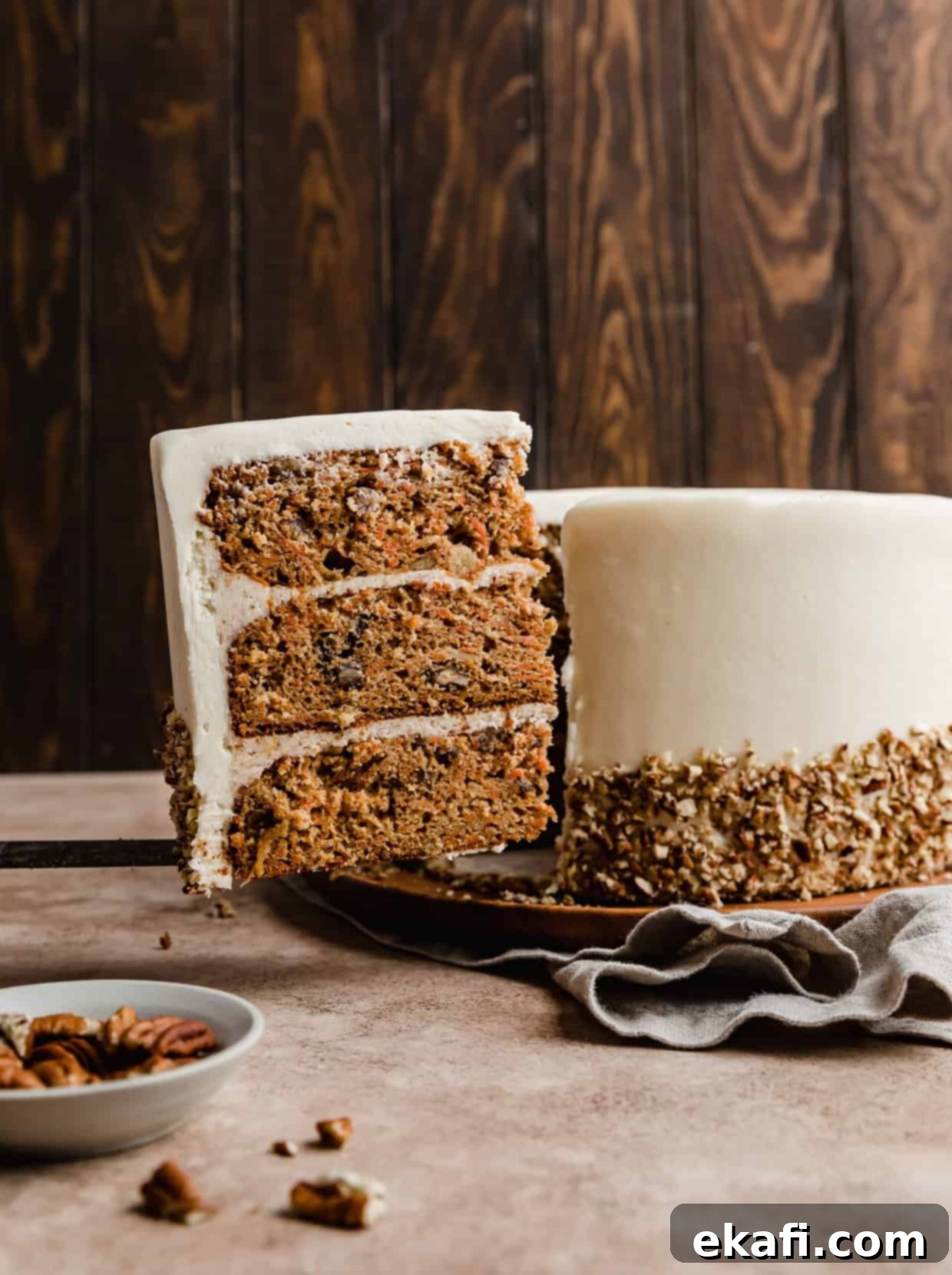The Ultimate Moist Carrot Cake with Pineapple, Pecans, and Decadent Cream Cheese Frosting
Prepare to experience a baking masterpiece with this extraordinary Carrot Cake, generously enriched with the vibrant flavors of crushed pineapple and the delightful crunch of toasted pecans. Far from a simple dessert, this recipe elevates the classic carrot cake to new heights, delivering a symphony of tastes and textures that will captivate your palate. Each bite reveals the perfect harmony of freshly shredded carrots, sweet and tangy pineapple, and aromatic, earthy pecans, all enveloped in a remarkably moist and flavorful cake base. But the indulgence doesn’t stop there; this magnificent creation features a unique toasted pecan cream cheese buttercream filling nestled between layers, culminating in a rich, velvety cream cheese frosting that truly sets it apart as the best carrot cake recipe you’ll ever encounter.
Incorporating fruits and vegetables into baked goods is not only a fantastic way to introduce delightful flavors and textures but also a clever method to sneak in some wholesome goodness. If you appreciate this approach, you might also enjoy my Chocolate Chip Zucchini Bread, which is brimming with fresh zucchini. For those who prefer a chocolate chip-free alternative, my Lemon Zucchini Bread offers a bright, refreshing twist. Utilizing ripe fruit is also effortless when making an Easy Banana Bread. And for a slightly simpler yet equally delightful carrot cake experience, be sure to explore my Carrot Coffee Cake.
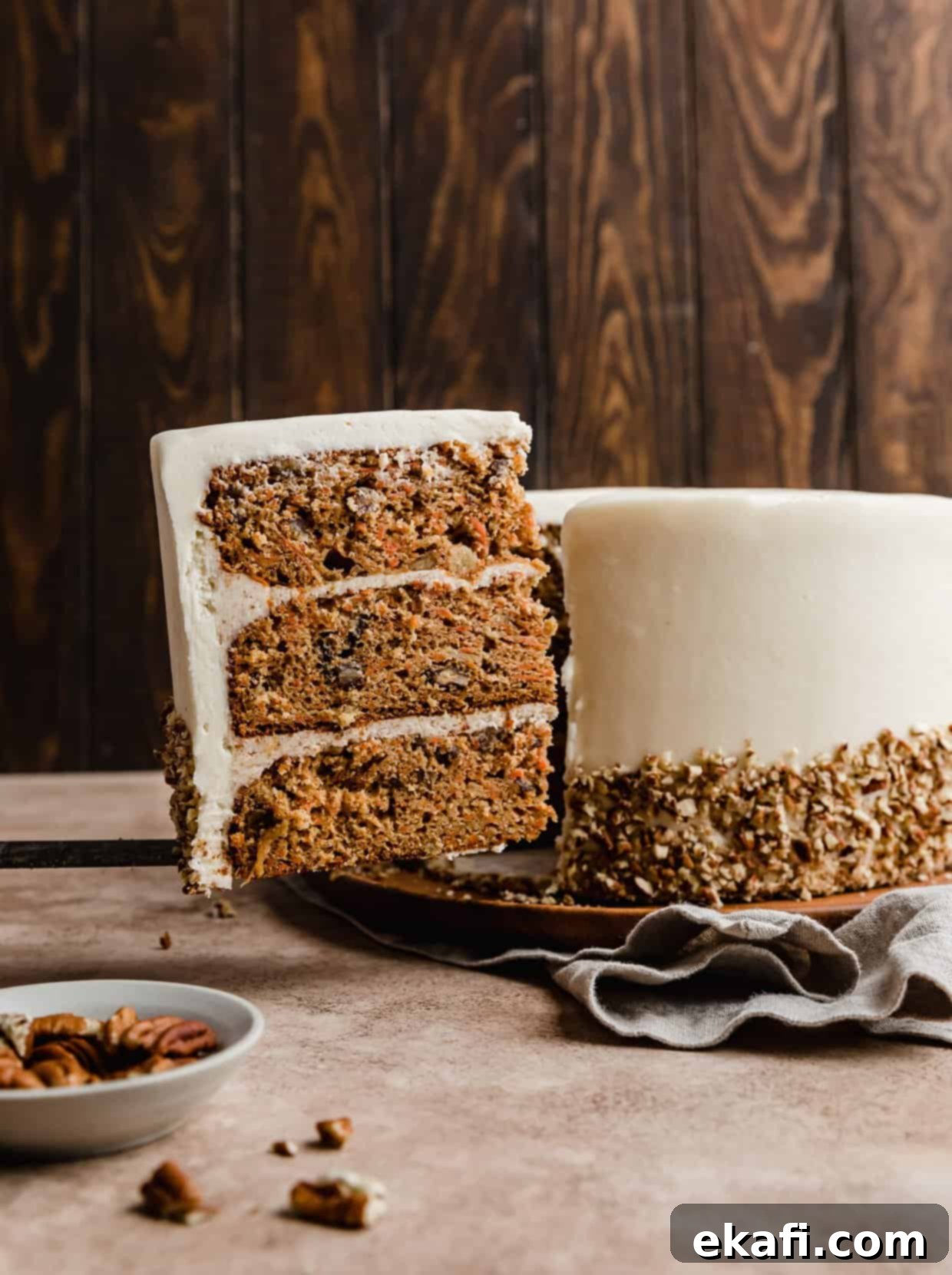
Why This Pineapple Pecan Carrot Cake Recipe Stands Out
This isn’t just another carrot cake; it’s a carefully crafted dessert designed to deliver an unparalleled experience. Here’s what makes this particular recipe truly special and why it consistently earns rave reviews:
- A Masterpiece of Textures: Every element in this cake contributes to a harmonious textural profile. The finely grated carrots integrate seamlessly, adding natural sweetness and tenderness without being overtly chunky. The toasted, chopped pecans introduce a delightful, nutty bite that provides a pleasant contrast without being overly hard. Meanwhile, the crushed pineapple not only infuses a bright, tropical flavor but also imparts an incredible moistness, creating a tender, almost melt-in-your-mouth crumb. This careful balance ensures a dynamic and satisfying mouthfeel with every forkful.
- Irresistible Toasted Pecan Buttercream Filling: What truly elevates this cake is the unique filling. We create a rich pecan paste from freshly toasted pecans, then blend it into a portion of our luscious cream cheese buttercream. This ingenious step ensures that the deep, earthy, and aromatic notes of the toasted pecans are distributed throughout the center of the cake, offering a burst of flavor in every layer and complementing the classic carrot cake spices perfectly. It’s a subtle yet impactful detail that transforms the entire dessert.
- An Elevated Take on an Old-Fashioned Favorite: While a good old-fashioned carrot cake with cream cheese frosting is always a treat, this recipe takes that beloved classic to an entirely new level. The thoughtful additions of pecans and pineapple work synergistically to create a more complex flavor profile and a superior texture. The blend of warm spices—cinnamon, nutmeg, cloves, and ginger—enhances the cozy, comforting essence of the cake. Furthermore, the combination of vegetable oil, eggs, and the natural liquid from the pineapple ensures an exceptionally moist crumb that remains tender for days. It’s a slice of pure perfection, guaranteed to impress.
Essential Ingredient Notes for the Perfect Carrot Cake
Achieving the best results for your carrot cake starts with understanding the role of each ingredient. Here’s a closer look at the key components and how to prepare them for optimal flavor and texture:
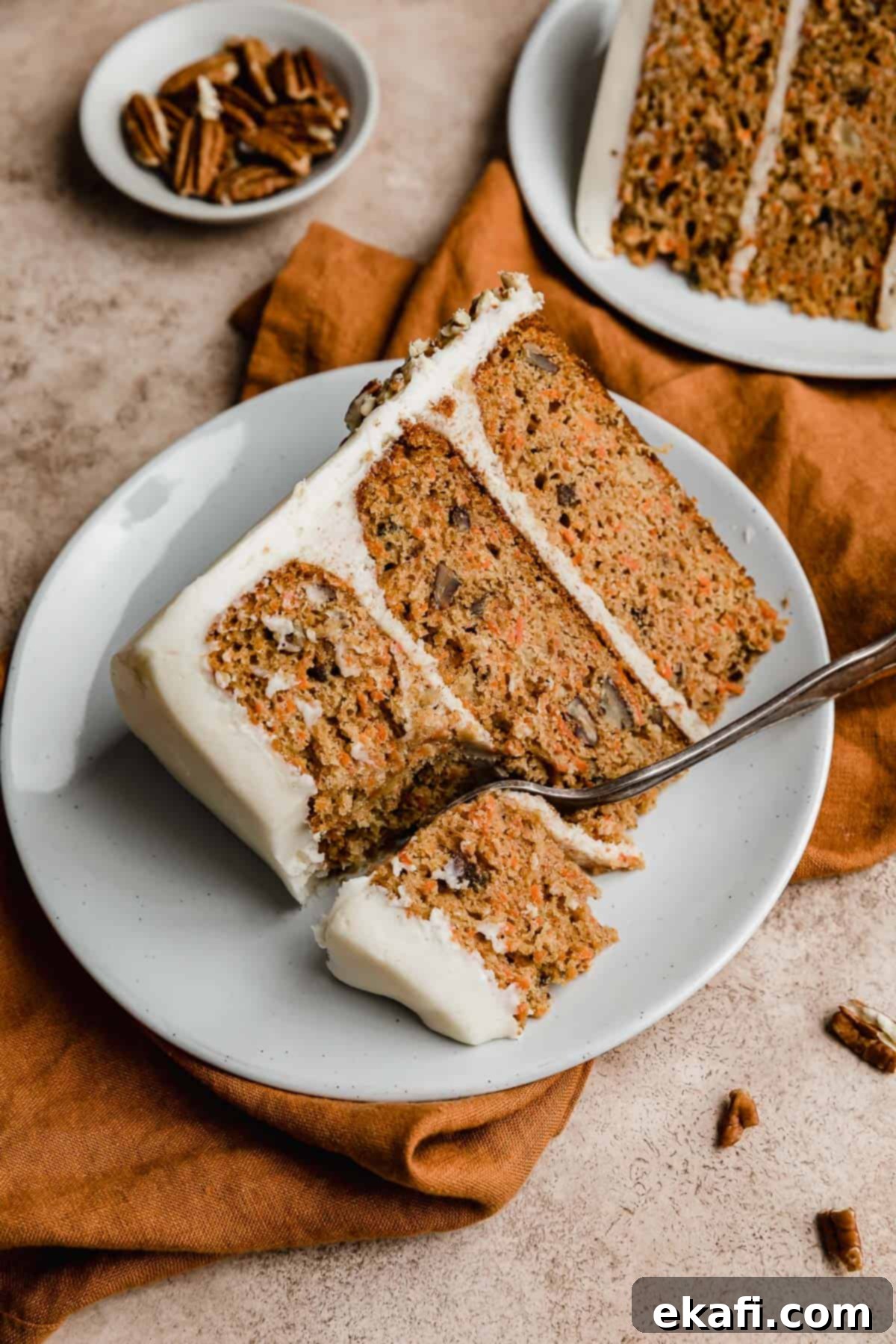
- Vegetable Oil: The choice of fat significantly impacts a cake’s texture. Using vegetable oil, which remains liquid at room temperature, is crucial for achieving an exceptionally moist, tender, and fine crumb in your carrot cake. Unlike butter (which is solid at room temperature and creates a more structured crumb), oil contributes a luxurious moistness that permeates every bite, making this cake wonderfully tender and rich.
- Crushed Pineapple: The crushed pineapple is a game-changer for moisture and flavor. It’s essential to lightly drain the can. You want to remove excess liquid to prevent the cake batter from becoming too thin, which could affect its texture and baking time. However, don’t squeeze out all the juice, as the remaining moisture is vital for the cake’s tenderness and the subtle tropical sweetness. This balance is key to its succulence.
- Light Brown Sugar: While granulated sugar provides sweetness, the addition of light brown sugar offers a deeper, more nuanced molasses flavor and contributes significantly to the cake’s moistness and a slightly chewier texture. Its fine granules also help create a uniform crumb, enhancing the overall appeal.
- Eggs: This recipe calls for a generous six large eggs, which might seem like a lot but serves a critical purpose. In baking, eggs provide essential structure and richness, binding ingredients together. Given the numerous inclusions in this cake—shredded carrots, pecans, and crushed pineapple—the higher egg content ensures the cake layers are robust enough to hold everything beautifully, creating a stable yet tender crumb that won’t crumble under the weight of these delicious additions. Ensure they are at room temperature for better emulsion with other ingredients.
- Spices: The soul of a truly great carrot cake lies in its warm, inviting spice blend. This recipe features a thoughtfully balanced combination of ground cinnamon, ground nutmeg, ground cloves, and ground ginger. These spices are not merely background notes; they infuse the cake with a fragrant warmth that perfectly complements the sweetness of the carrots and pineapple, creating a comforting and incredibly aromatic experience.
- Carrots: For the most flavorful and moist carrot cake, always opt for freshly shredded or grated carrots. Pre-shredded carrots from the store tend to be drier. Freshly grated carrots release their natural juices during baking, which seeps into the cake batter, ensuring an even softer crumb and a more pronounced carrot flavor.
- Pecans: Toasting the pecans before incorporating them is a non-negotiable step. This process intensifies their nutty flavor and adds a deeper aroma, which will be evident in both the cake layers and the special pecan buttercream filling. Chopped finely, they provide a lovely textural contrast without overwhelming the softness of the cake.
- Unsalted Butter: For the buttercream, unsalted butter is preferred as it gives you control over the salt content. It should be slightly softened but still cool to the touch. This consistency is ideal for whipping into a light and fluffy frosting, preventing it from becoming too oily or soupy.
- Cream Cheese: The cream cheese is the star of the frosting, giving it its signature tangy flavor and incredibly smooth texture. Be aware that cream cheese makes the buttercream softer than traditional buttercreams. Keeping the frosting chilled will be crucial during the assembly process to maintain its structure and ease of handling.
- Powdered Sugar: To achieve a perfectly smooth and lump-free buttercream, sifting the powdered sugar is essential. This step removes any clumps and ensures a silky consistency that’s easy to spread and pipe, leading to a professional-looking finish.
- Heavy Cream: Heavy cream is incorporated into the buttercream to lighten its texture and make it wonderfully fluffy. As it’s beaten, the heavy cream aerates the frosting, transforming it into a luxurious, whipped consistency that’s both rich and airy.
Step-by-Step Guide to Baking Your Masterpiece Carrot Cake
Follow these detailed steps carefully to ensure your carrot cake turns out perfectly moist, flavorful, and beautifully assembled. This recipe is designed for success, even if you’re new to layer cakes.
- Toast the Pecans: Begin by toasting your pecans, a crucial step for enhancing their nutty flavor. Spread all the pecans (both for the cake batter and the buttercream) in an even layer on a baking sheet. Toast them in a preheated oven at 350°F (175°C) for 3-7 minutes. Keep a very close eye on them, as nuts can burn quickly; they should smell fragrant and be lightly browned. Once toasted, remove from the oven and set aside to cool completely.
- Prepare the Cake Pans: Thoroughly prepare three 8-inch round cake pans. Lightly spray each pan with nonstick baking spray, then line the bottom of each pan with a circle of parchment paper. Spray over the parchment paper again. This double layer of protection ensures your delicate cake layers will release easily after baking.
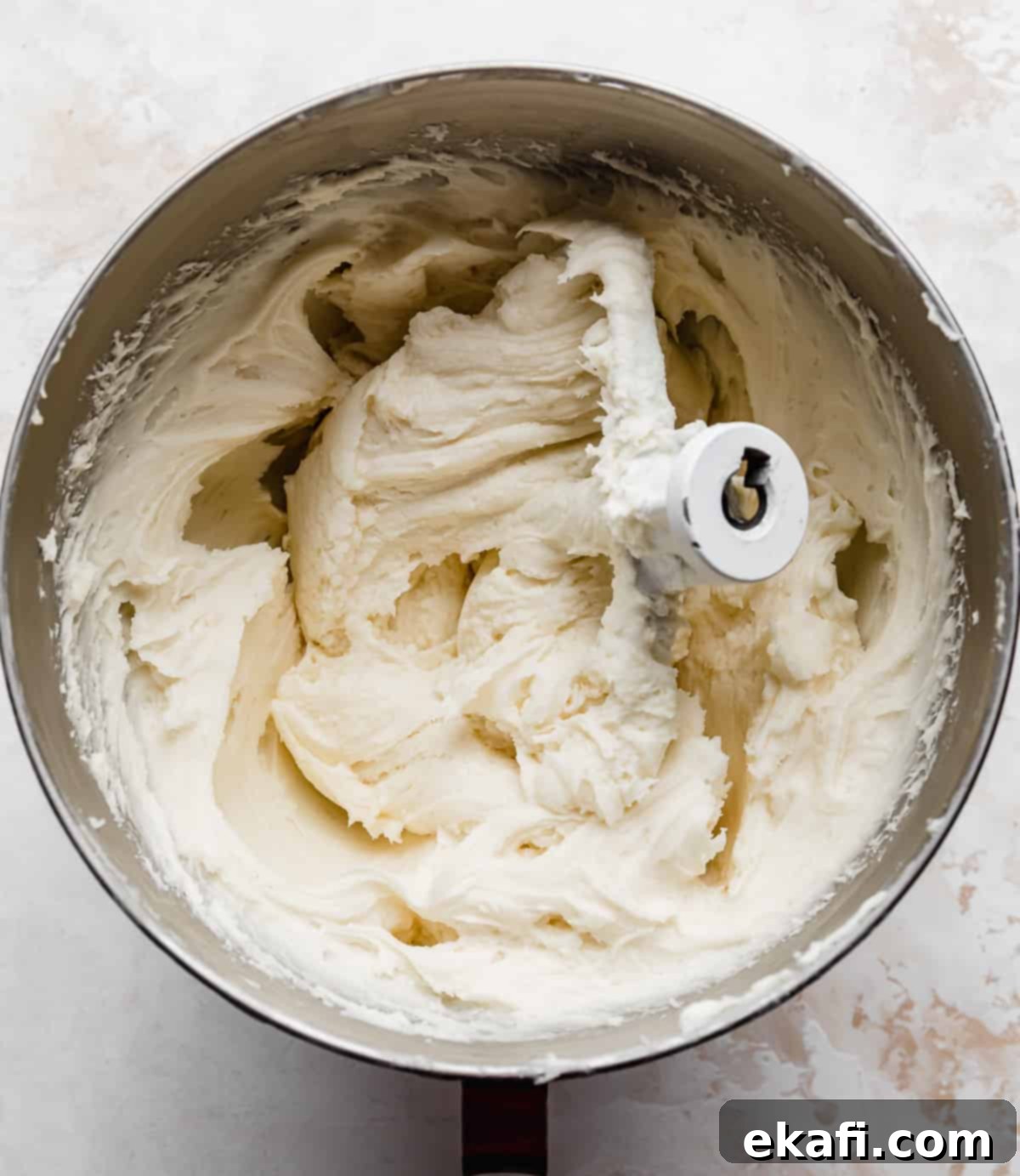
- Prepare the Cake Batter: In a medium bowl, sift together the flour, baking powder, baking soda, salt, ground cinnamon, nutmeg, cloves, and ginger. Sifting ensures there are no lumps and helps distribute the leavening agents evenly. Set this dry mixture aside. In the bowl of a stand mixer fitted with a paddle attachment, combine the vegetable oil, lightly drained crushed pineapple, granulated sugar, packed light brown sugar, room temperature eggs, and vanilla extract. Beat on medium speed for about 2 minutes until the mixture is well combined, light in color, and slightly fluffy. Gradually add the sifted dry ingredients to the wet mixture, mixing on low speed until just combined. Be careful not to overmix. Remove the bowl from the stand mixer and gently fold in the freshly shredded carrots and the chopped, toasted pecans with a spatula until evenly distributed.
- Bake the Cake Layers: Divide the prepared cake batter evenly among the three prepared 8-inch cake pans. Bake in the preheated 350°F (175°C) oven for 23-28 minutes. The cakes are done when a wooden toothpick inserted into the center comes out with just a few moist crumbs attached, not wet batter, and not completely dry. Once baked, let the cakes cool in their pans on a wire rack for 10 minutes. This allows them to firm up slightly before you attempt to remove them. After 10 minutes, invert the cakes onto the cooling rack, carefully peel off the parchment paper, and let them cool completely before frosting. This step is crucial; attempting to frost warm cakes will result in melted frosting.
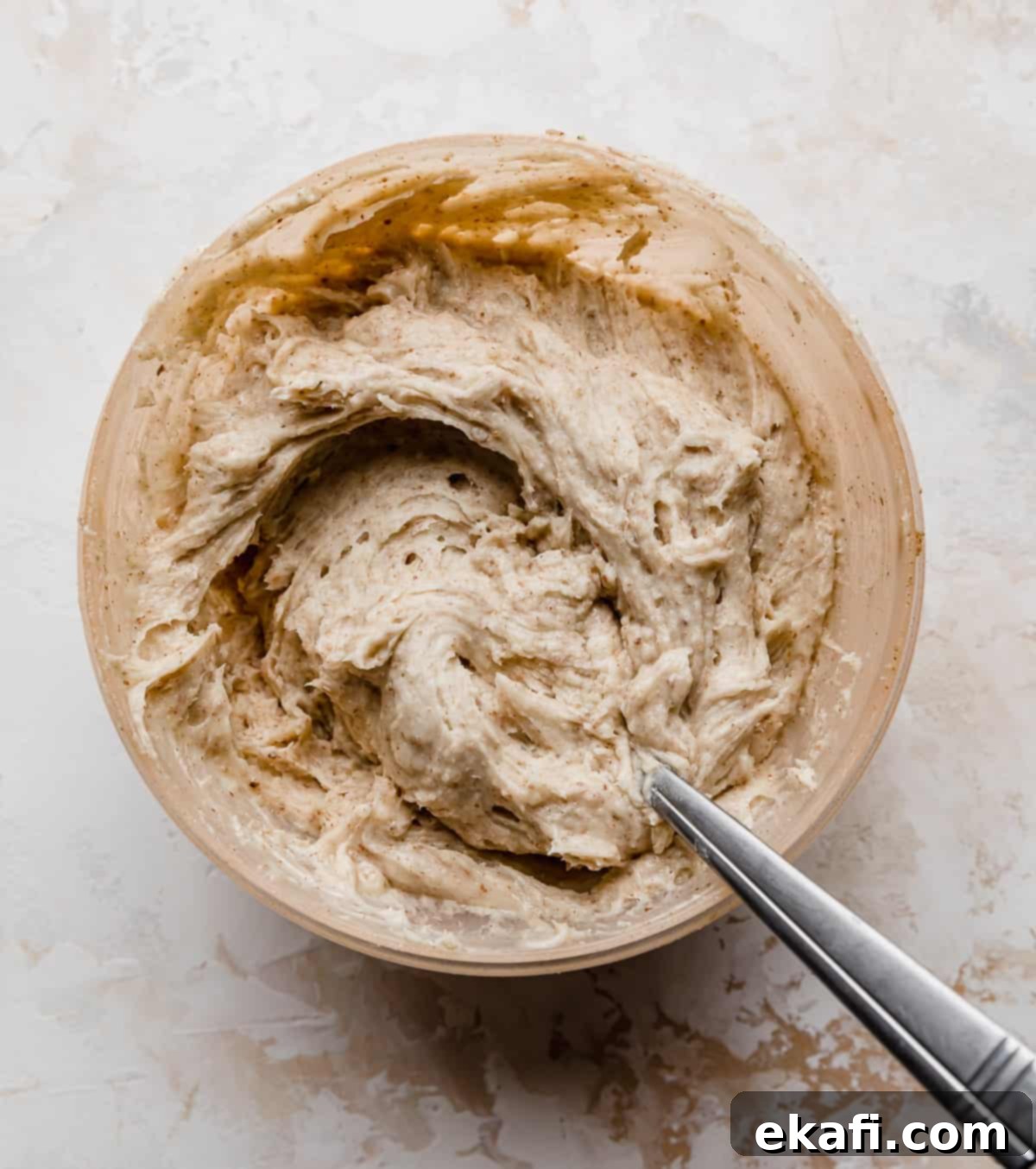
- Make the Cream Cheese Buttercream: In the bowl of a stand mixer fitted with a paddle attachment, beat the slightly softened unsalted butter, cream cheese, and a pinch of salt on medium-high speed until the mixture is light in both color and texture, and wonderfully smooth. This should take a few minutes. Reduce the speed to low, then gradually add the vanilla extract and sifted powdered sugar, one cup at a time, mixing thoroughly after each addition until fully incorporated. If the frosting appears too stiff, add heavy cream one tablespoon at a time until it reaches a smooth, spreadable consistency. Once all the powdered sugar is added, increase the speed to medium-high and beat for an additional 1-2 minutes until the buttercream is perfectly combined, light, and fluffy. Set aside 2 cups of this plain cream cheese buttercream for the pecan filling.
- Make the Pecan Buttercream Filling: Take 4 ounces (about 1 cup of halves) of the cooled toasted pecans and add them to a food processor. Process the pecans until they form a smooth, buttery paste. You may need to stop and scrape down the sides of the food processor a few times to ensure an even consistency. Add this freshly made pecan paste to the 2 cups of reserved cream cheese buttercream. Mix until the pecan paste is fully incorporated, creating a delicious, nutty filling. Store both the plain cream cheese buttercream and the pecan buttercream in the fridge while the cake layers cool.
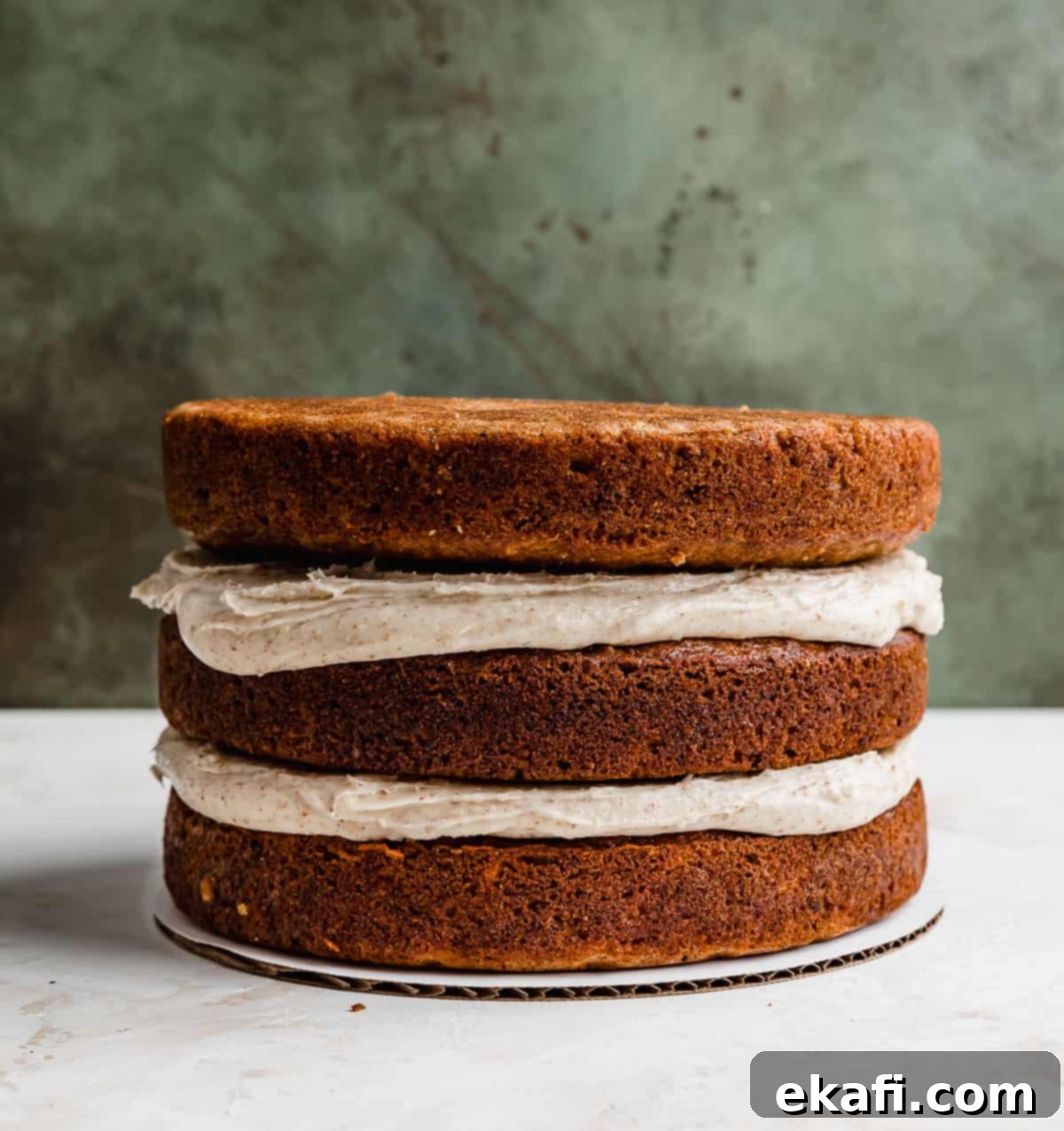
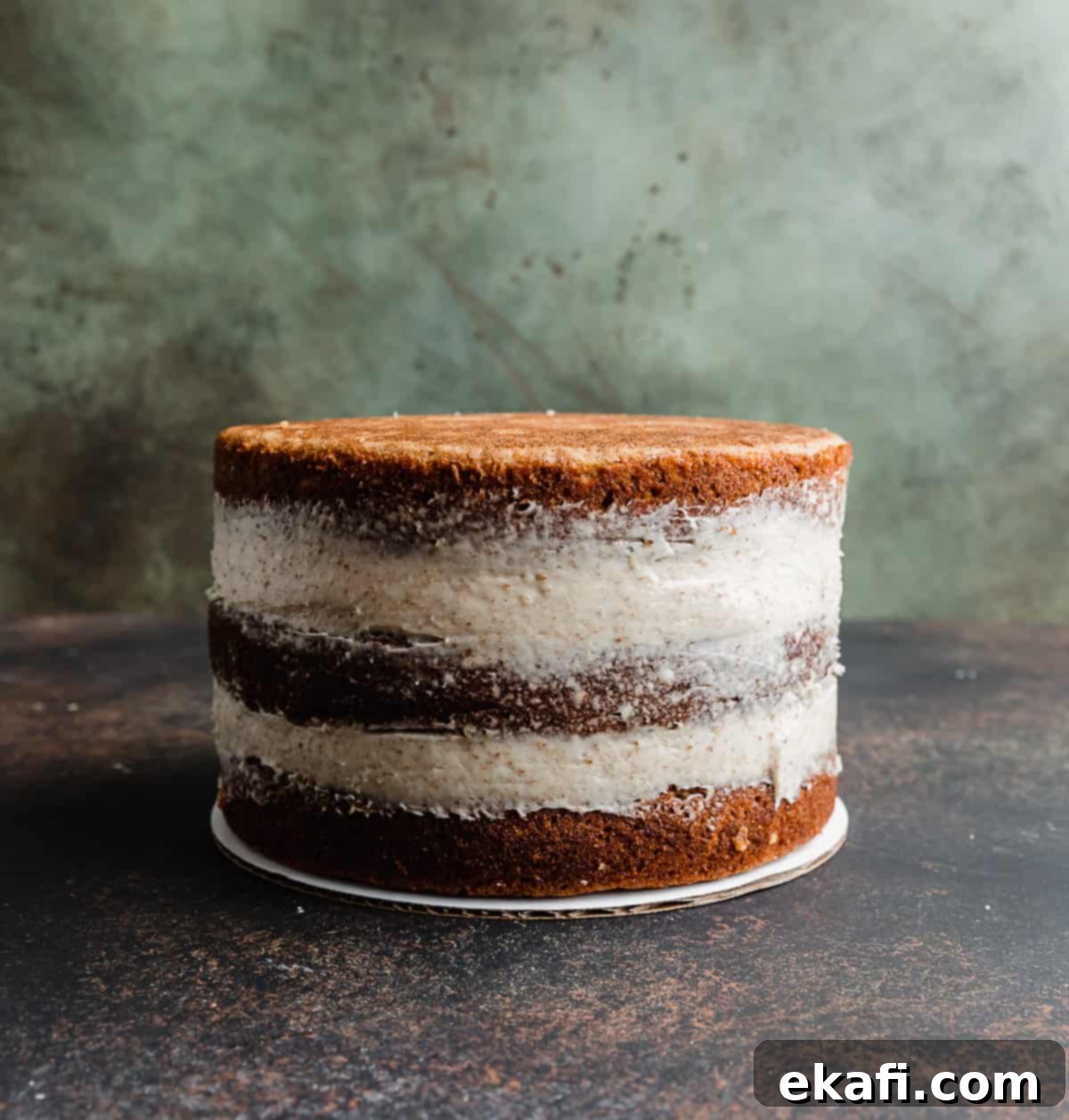
- Assemble the Cake: Approximately 40 minutes before you plan to decorate, remove both the plain cream cheese buttercream and the pecan buttercream from the fridge. Allow them to soften slightly at room temperature, then re-beat them in a stand mixer on medium speed until they return to a smooth, light, and spreadable consistency. Place a small dollop of the plain cream cheese buttercream on your chosen cake board or serving platter; this acts as an adhesive to keep the cake stable. Place the first cooled cake layer centered on top. Spread half of the pecan cream cheese buttercream evenly over this first cake layer. Carefully place the second cake layer on top, then spread the remaining pecan buttercream over it. Finally, place the third cake layer on top, this time with the bottom side facing up (this creates a flatter, more even top surface for frosting).
- Apply the Crumb Coat: Using an offset spatula, apply a thin, even layer of the plain cream cheese buttercream around the entire cake, covering both the top and sides. This is known as a crumb coat, and its purpose is to trap any loose crumbs, preventing them from mixing into your final layer of frosting. Once coated, place the cake in the freezer for 15-20 minutes, or until the crumb coat is firm to the touch. This step is crucial for a smooth, professional finish.
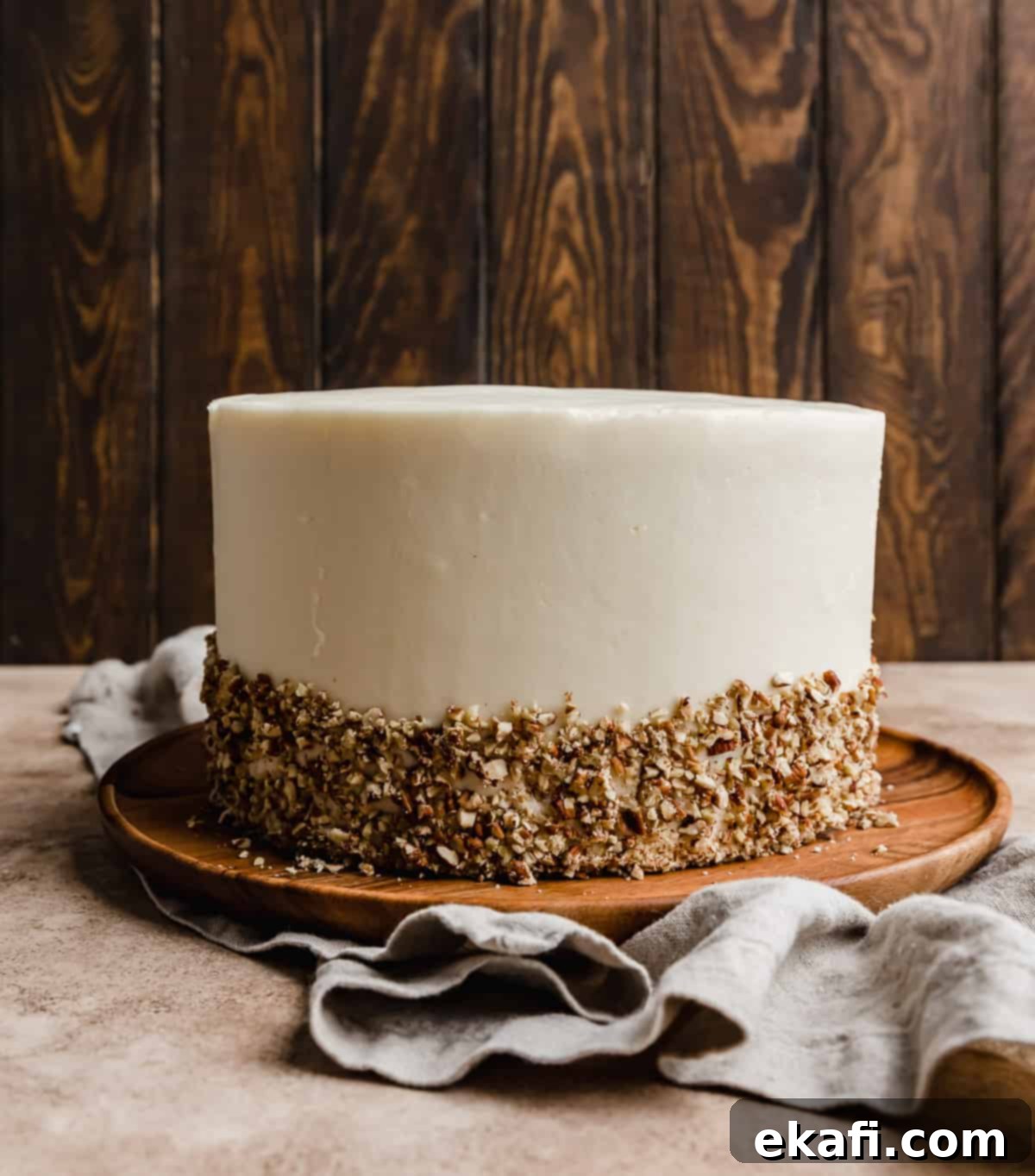
- Final Frosting and Decoration: Once the crumb coat is firm, apply the remaining plain cream cheese buttercream in a thicker, final layer over the entire cake. Smooth it out with your offset spatula or a bench scraper. Decorate as desired! For a classic and elegant touch, we gently pressed chopped toasted pecans around the bottom third of the cake, using an offset spatula to help adhere them evenly. You can also pipe decorative swirls on top or create other designs to personalize your masterpiece.
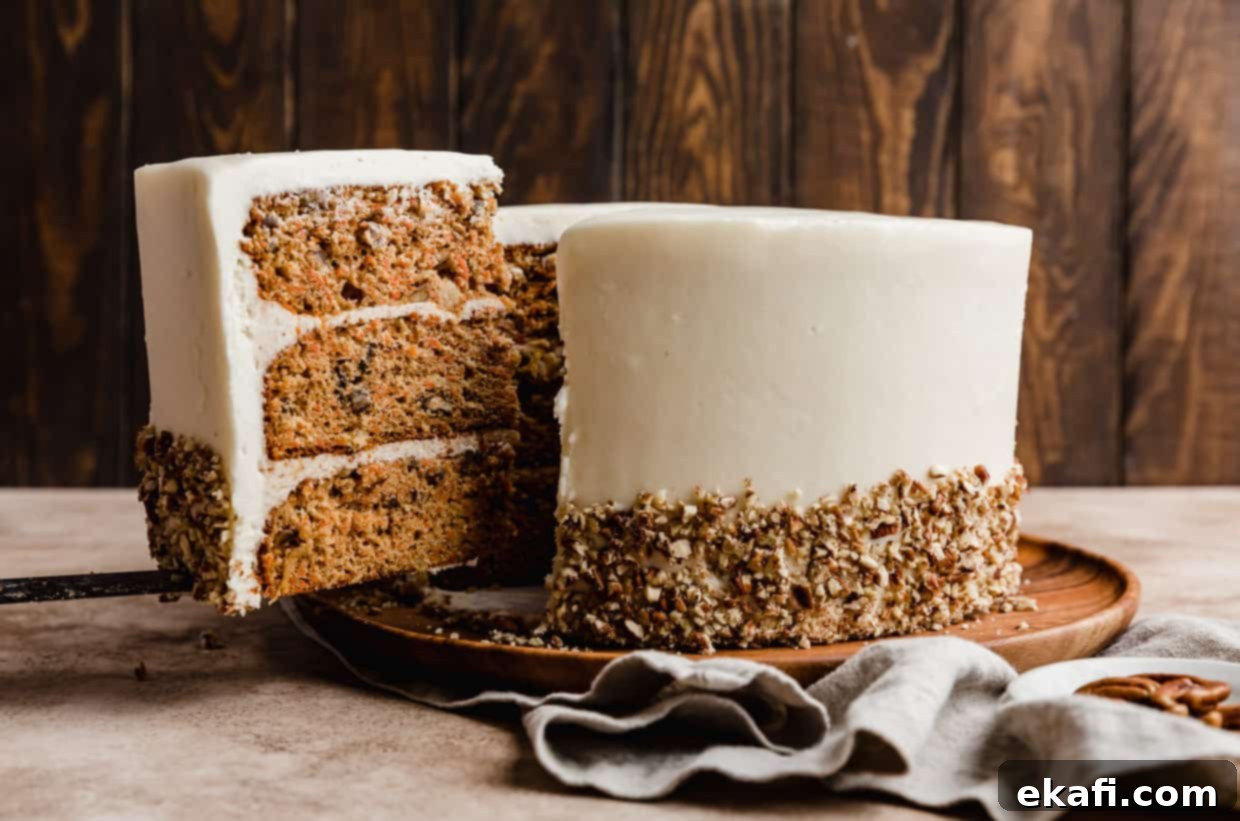
Expert Tips for Baking Your Best Carrot Cake
Baking a show-stopping carrot cake involves a few key techniques. These expert tips will help you achieve perfect results every time, ensuring a moist cake and flawless frosting:
- Achieving Perfect Cake Doneness: The baking time for the cake layers is incredibly important. Underbaked layers will be too soft, causing them to sink in the middle and potentially be gummy. Overbaked layers, on the other hand, will result in a dry, crumbly cake—a common pitfall. To ensure your cakes are baked just right, watch them closely as they approach the end of the recommended baking time. A useful trick is to gently tap the side of the oven door; if the centers of the cakes jiggle noticeably, they need a bit more time. Insert a wooden toothpick into the center; it should come out with a few moist crumbs, not wet batter, and not completely clean. Add baking time in very small increments, like one minute at a time, to avoid overbaking. Even two extra minutes can make the difference between a perfectly baked and an overly dry cake.
- Working with Cream Cheese Buttercream: Cream cheese buttercream is famously softer and more delicate than traditional buttercreams due to the high moisture content of cream cheese. This means your fridge and freezer will be your best allies during the decorating process.
- If the buttercream gets too soft: If your frosting becomes too soft to hold its shape while you’re working, place the bowl of buttercream in the refrigerator for about 20 minutes. This will help it firm up slightly, making it much easier to spread or pipe.
- Preventing frosting bulge between layers: If you notice the frosting starting to bulge or squeeze out from between your cake layers after stacking, it means the buttercream is too warm and soft. Immediately place the assembled cake in the freezer for about 10-15 minutes. This quick chill will help the frosting firm up, stopping the bulge and stabilizing the layers.
- Mastering Mixing Techniques: For a tender cake, pay attention to your mixing. When combining the wet ingredients (oil, pineapple, sugars, eggs, vanilla), you want to beat them together really well, ensuring they are fully emulsified and light. However, once you introduce the dry ingredients (flour, leaveners, spices), switch to a low speed and mix only until they are *just combined*. Overmixing the batter after adding the dry ingredients develops too much gluten, which can lead to a tough, dense cake. Stop mixing as soon as you no longer see streaks of dry flour.
- Ensuring Enough Frosting for Decorations: The provided recipe for cream cheese buttercream is ample for filling and frosting a three-layer cake with a smooth finish. However, if you plan to add elaborate piping, decorative swirls, or a more generously thick final layer of frosting on top, consider making an additional 1/4 of the cream cheese buttercream recipe. This ensures you have plenty to work with for all your creative decorative touches.
Make-Ahead, Storing, and Freezing Your Carrot Cake
This delicious carrot cake can be prepared in stages, making it perfect for entertaining or enjoying over several days. Here’s how to manage it:
- Making Cake Layers Ahead: You can bake the carrot cake layers in advance. Once they are completely cooled, individually wrap each layer tightly in plastic wrap. They can be stored in the refrigerator for 1-2 days before you’re ready to assemble and frost the cake.
- Preparing Buttercream in Advance: The cream cheese buttercream can also be made ahead of time. Transfer it to an airtight container and store it in the refrigerator for 1-2 days. Before using, remove it from the fridge and let it sit at room temperature for about 10-15 minutes to soften slightly. Then, re-beat it in a stand mixer on medium speed until it returns to its original fluffy, light, and spreadable texture.
- Storing Unfrosted Cake Layers: For longer storage, tightly wrap individual cake layers (I usually wrap them in two layers of plastic wrap) and place them on a flat surface in the fridge or freezer. If you need to store the cake layers for more than 2 days in the refrigerator, freezing is recommended for optimal freshness. For freezing beyond 7 days, add an additional layer of aluminum foil around the plastic-wrapped layers to prevent freezer burn. When you’re ready to use them, transfer the frozen layers to the refrigerator (still wrapped) and let them thaw completely. Cake layers will keep well in the freezer for up to 2 months.
- Freezing Buttercream: You can also freeze the buttercream in an airtight container for up to 2 months. To use, transfer it to the refrigerator to thaw overnight, then re-beat it until fluffy.
- Storing Decorated Carrot Cake: A fully decorated carrot cake with pineapple and pecans can be stored in the refrigerator overnight, uncovered. This helps the frosting firm up. If you need to store it for a longer period, flash freeze the decorated cake in the freezer until the buttercream is completely solid (this prevents smudging). Once firm, wrap the cake twice in plastic wrap and store it in the freezer for up to 7 days. For even longer storage, add an additional layer of aluminum foil over the plastic wrap.
- Important Note on Cream Cheese Buttercream & Freezing: It’s important to remember that cream cheese buttercream does not set or freeze as firmly as a traditional buttercream frosting (made primarily with butter and powdered sugar). Even when frozen, it will retain a slightly tacky or softer texture compared to other frostings. Keep this characteristic in mind when wrapping and freezing your decorated cake.
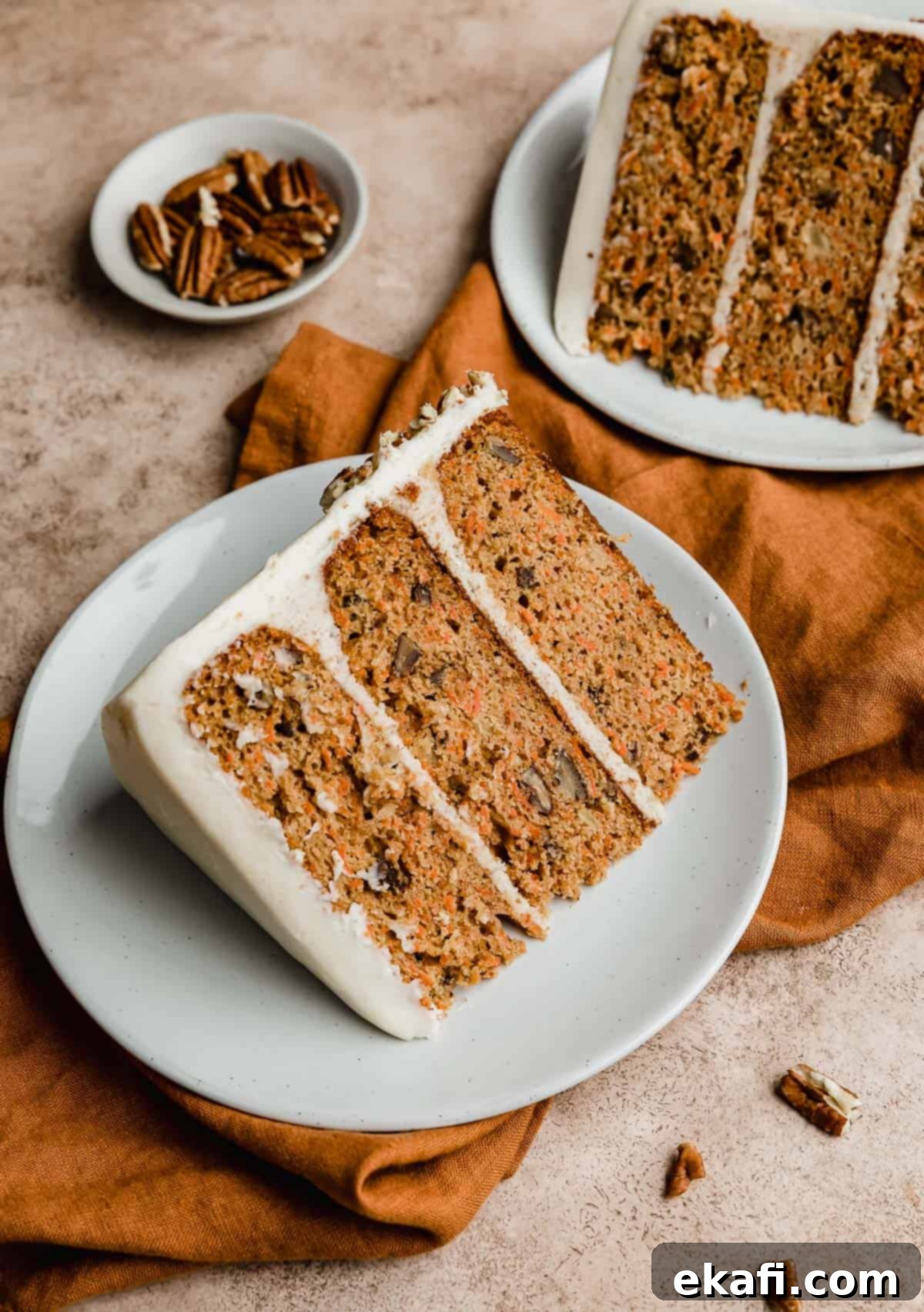
Frequently Asked Questions About This Carrot Cake Recipe
Here are answers to some common questions that arise when making this incredible carrot cake:
While you might be tempted to use chunky pineapple for a more prominent pineapple texture, I highly recommend sticking with crushed pineapple for this recipe. I haven’t tested it with chunky pineapple, and using larger pieces could significantly impact the cake’s delicate structure and evenness of bake. Crushed pineapple effectively infuses the cake with its delicious flavor and contributes to the overall moistness without creating large, dense pockets of fruit that could alter the crumb or cause the cake to become too wet in certain spots. It’s all about maintaining that perfect balance of texture and moisture.
If pecans aren’t your preference or are unavailable, a fantastic substitute is walnuts. They offer a similar earthy, nutty flavor and a pleasing texture when toasted. You can toast walnuts in the same manner as pecans and then process them into a paste for the buttercream filling between the layers. The flavor profile will be slightly different but equally delicious. Alternatively, if you wish to exclude nuts altogether due to allergies or preference, that is perfectly fine! The cake will still be wonderfully moist and flavorful from the pineapple and spices, just without the added crunch.
Absolutely, you can use dark brown sugar instead of light brown sugar if that’s what you have on hand or if you prefer a more intense flavor. The primary difference you’ll notice is that dark brown sugar will impart a richer, deeper caramel-like flavor and a slightly darker color to your carrot cake. This is because dark brown sugar contains more molasses than its light counterpart. This can actually enhance the warm spice notes in the cake, making for an even more decadent and robust dessert. So, feel free to make that substitution for a deeper taste experience!
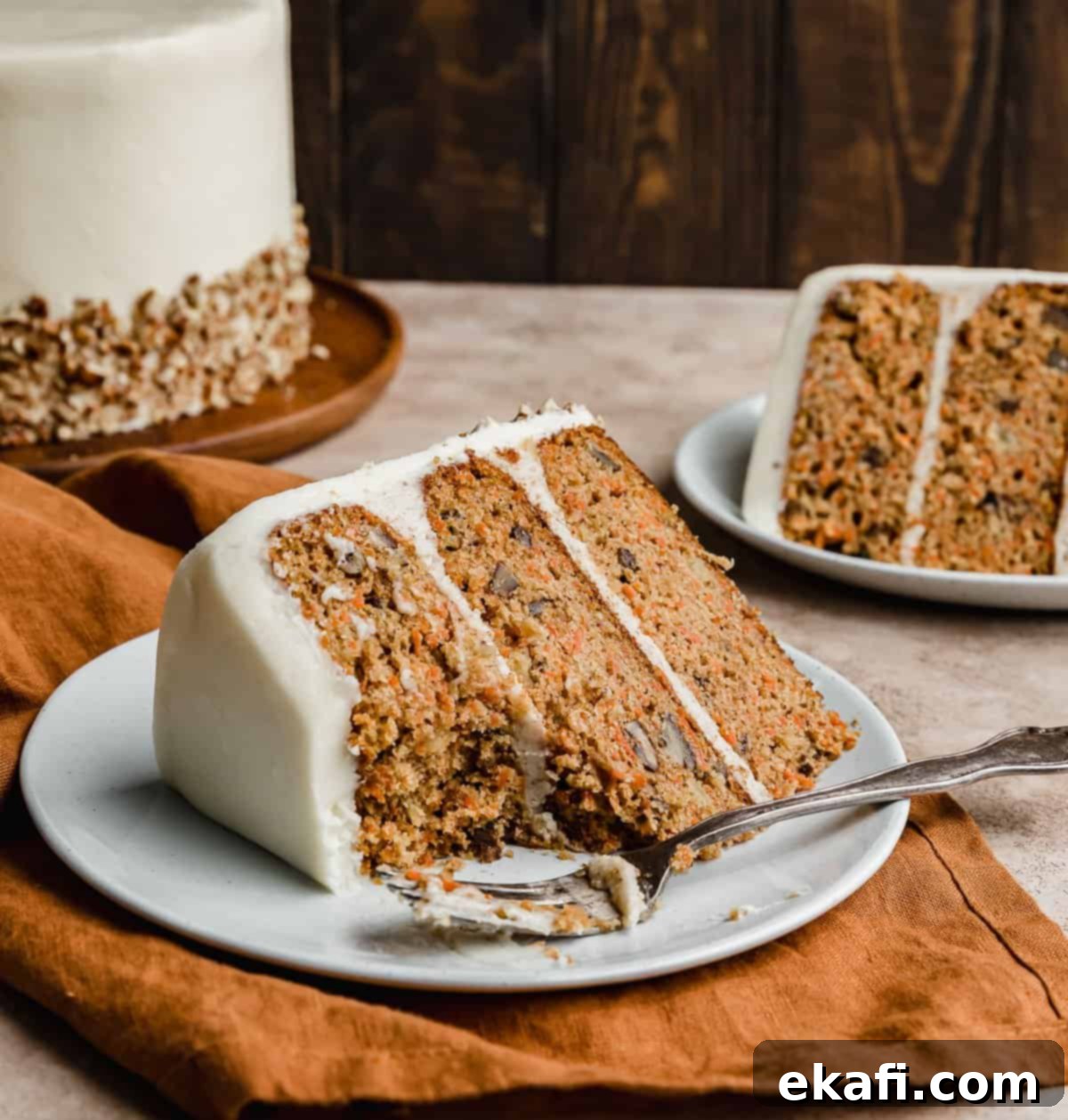
Explore More Delicious Cake Recipes
If you loved this carrot cake, you’ll surely enjoy exploring our other delightful cake creations. Each recipe is crafted to bring joy to your baking endeavors and sweet moments to your table.
- Warm & Comforting Spice Cake
- Delightful Apple Cider Bundt Cake
- Rich Pumpkin Layer Cake with Cream Cheese Frosting
- Bright & Zesty Lemon Poppy Seed Cake
- Sweet & Tangy Lemon Bar Cake
Did you bake this magnificent carrot cake? We’d absolutely love to hear about your experience! Click here to leave a rating and review directly on the blog post, or simply scroll down to the recipe card section below to share your thoughts. Your feedback helps our community!
Stay up-to-date with our latest delicious recipes and baking tips by following us on Instagram, TikTok, Facebook, and Pinterest. Don’t miss out on any baking inspiration!
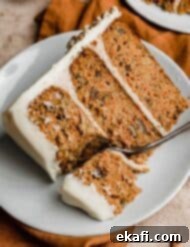
Print
SaveSaved!
Review
Moist Carrot Cake (with pineapple and pecans)
Ingredients
Carrot Cake
- 1 cup vegetable oil
- 3/4 cup canned crushed pineapple – lightly drained
- 1 cup granulated sugar
- 1 cup light brown sugar – packed
- 6 large eggs – room temperature
- 1 tablespoon vanilla extract
- 3 1/4 cups all purpose flour
- 1 tablespoon baking powder
- 1 teaspoon baking soda
- 1 teaspoon salt
- 2 1/2 teaspoons ground cinnamon
- 3/4 teaspoon nutmeg
- 1/4 teaspoon ground cloves
- 1/8 teaspoon ground ginger
- 4 cups freshly shredded carrots – lightly packed
- 1 cup toasted pecans – chopped
Cream Cheese Buttercream
- 2 cups unsalted butter – slightly softened
- 16 oz cream cheese
- 8+ cups powdered sugar – sifted
- pinch salt
- 2 tablespoons heavy cream
- 4 oz pecans – toasted, about 1 cup of toasted pecan halves
Instructions
Carrot Cake
-
Preheat oven to 350° F. Toast the pecans (you can also toast the ones you’ll need for the buttercream at the same time). Spread the pecans evenly over a sheet pan and toast in the oven for 3-7 minutes, or until they smell nutty and have slightly browned. Be sure to keep a close eye on them so they don’t burn! Set aside to cool.
-
Prepare three 8-inch round cake pans by spraying with nonstick spray and lining the bottom with parchment paper. Spray on top of the parchment paper.
-
In a medium bowl sift together the flour, baking powder, baking soda, salt, and spices. Set aside.
-
In the bowl of a stand mixer fitted with a paddle attachment, mix together the vegetable oil, crushed pineapple, granulated sugar, brown sugar, eggs, and vanilla. Mix on medium speed for about 2 minutes.
-
Slowly add the dry ingredients to the mixer and mix until just combined. Fold in the shredded carrots and chopped pecans.
-
Divide the batter evenly between the three 8-inch pans and bake for 23-28 minutes, or until a toothpick inserted in the center comes out with just a couple crumbs stuck to it.
-
Remove from the oven and let cool in the pans for 10 minutes. Turn cakes out of pans onto a cooling rack until they’ve cooled completely.
-
Level cake layers, if needed.
-
If making the layers in advance, wrap completely with plastic wrap and store in the fridge for 1-2 days, or the freezer for 2-3 weeks.
Cream Cheese Buttercream
-
In the bowl of a stand mixer fitted with a paddle attachment, beat the butter, cream cheese, and salt until it’s smooth and light in texture and color.
-
Add the vanilla and powdered sugar, a couple cups at a time, mixing well before each addition. Add a tablespoon of heavy cream as needed to keep the frosting smooth and not too stiff. Repeat until all the powdered sugar and cream are added. If the frosting is too soft when it’s cold, add more powdered sugar in 1/2 cup increments to thicken it.
-
Set aside 2 cups of the prepared buttercream.
-
To a food processor, add 4 oz of toasted pecans and process until a paste forms. Scrape the sides of the food processor as needed.
-
Add the toasted pecan paste to the 2 cups of prepared cream cheese buttercream and mix well.
-
Store the pecan buttercream and the plain cream cheese buttercream in the fridge. About 40 minutes before decorating the cake, remove the buttercream from the fridge. Once the buttercream has slightly softened, use a stand mixer and beat it on medium speed to make it smooth and spreadable.
Assembly
-
Put a small dollop of buttercream on a cake board and place the first layer of cake on the board.
-
Spread half of the pecan cream cheese buttercream over the top of the first cake layer. Place the next cake layer on top of the pecan buttercream and spread the rest of the pecan buttercream on top.
-
Lay the third cake layer, flat side up, on top of the cake and apply a thin layer (crumb coat) of cream cheese buttercream to the entire cake and freeze for about 15-20 minutes, until the buttercream is firm.
-
Once the buttercream is firm, add the final layer of frosting around the cake, decorating as desired. We gently pressed chopped, toasted pecans around the bottom of the cake using an offset spatula.
Notes
- Getting the correct doneness when baking the cake layers is so important. If they’re underbaked, they’ll be too soft in the middle and sink. If they get overbaked, the cake will turn out dry. Watch the cakes closely when they’re approaching the end of the baking time to ensure they’re baked just right.
- Cream cheese buttercream is softer than other buttercreams, so the fridge and freezer will be your best friends as you’re decorating this cake. If the buttercream is getting too soft and not holding its shape, refrigerate for about 20 minutes so it can get a little more firm again. If the frosting between the cake layers is starting to bulge on the sides, put the cake in the freezer for about 10-15 minutes to help it firm up and stop bulging.
See Recipe Tips in the blog post for additional tips and storing/freezing directions.
Nutrition
